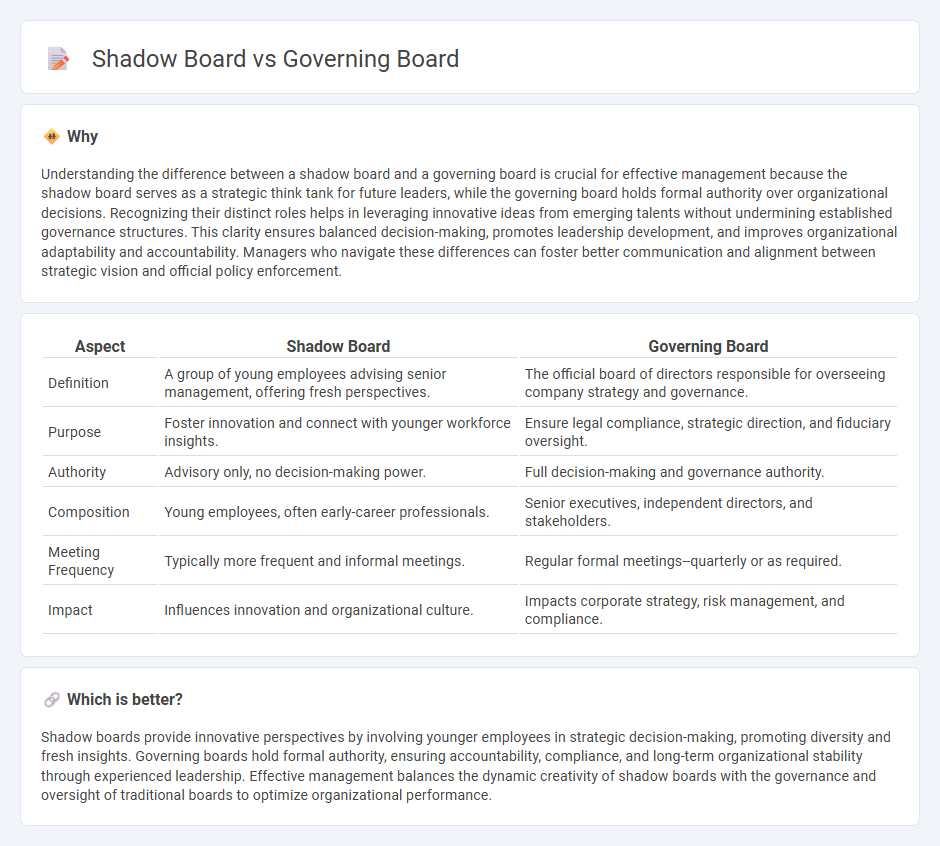
Shadow boards consist of younger employees who provide innovative insights and fresh perspectives to senior management, enhancing decision-making agility. Governing boards, composed of experienced executives and stakeholders, hold formal authority overseeing strategic direction and corporate governance. Explore the distinct roles and benefits of shadow boards versus governing boards to optimize organizational leadership.
Why it is important
Understanding the difference between a shadow board and a governing board is crucial for effective management because the shadow board serves as a strategic think tank for future leaders, while the governing board holds formal authority over organizational decisions. Recognizing their distinct roles helps in leveraging innovative ideas from emerging talents without undermining established governance structures. This clarity ensures balanced decision-making, promotes leadership development, and improves organizational adaptability and accountability. Managers who navigate these differences can foster better communication and alignment between strategic vision and official policy enforcement.
Comparison Table
| Aspect | Shadow Board | Governing Board |
|---|---|---|
| Definition | A group of young employees advising senior management, offering fresh perspectives. | The official board of directors responsible for overseeing company strategy and governance. |
| Purpose | Foster innovation and connect with younger workforce insights. | Ensure legal compliance, strategic direction, and fiduciary oversight. |
| Authority | Advisory only, no decision-making power. | Full decision-making and governance authority. |
| Composition | Young employees, often early-career professionals. | Senior executives, independent directors, and stakeholders. |
| Meeting Frequency | Typically more frequent and informal meetings. | Regular formal meetings--quarterly or as required. |
| Impact | Influences innovation and organizational culture. | Impacts corporate strategy, risk management, and compliance. |
Which is better?
Shadow boards provide innovative perspectives by involving younger employees in strategic decision-making, promoting diversity and fresh insights. Governing boards hold formal authority, ensuring accountability, compliance, and long-term organizational stability through experienced leadership. Effective management balances the dynamic creativity of shadow boards with the governance and oversight of traditional boards to optimize organizational performance.
Connection
Shadow boards consist of younger employees who provide fresh perspectives and innovative ideas to the Governing board, enhancing strategic decision-making processes. The Governing board relies on insights from the Shadow board to better understand emerging trends and the evolving needs of the workforce, driving organizational agility. This connection fosters stronger collaboration, ensuring that long-term governance aligns with innovative approaches and employee engagement.
Key Terms
Decision-making authority
A governing board holds formal decision-making authority, legally responsible for the organization's strategic direction, financial oversight, and policy enforcement. A shadow board operates as an advisory group, often composed of emerging leaders or external experts, providing insights and recommendations without binding decision power. Explore how these structures influence corporate governance and leadership dynamics.
Strategic oversight
A governing board holds formal authority, responsible for strategic oversight, regulatory compliance, and fiduciary duties that ensure organizational accountability and long-term success. A shadow board, typically composed of younger or diverse employees, offers informal, innovative perspectives to influence strategic decisions and challenge the status quo without formal power. Explore the distinct roles and benefits of both boards to enhance your organization's governance structure.
Organizational influence
The governing board holds formal authority and strategic decision-making power, directly shaping organizational policies and long-term goals. In contrast, the shadow board consists of emerging leaders who provide fresh perspectives and innovative ideas without formal decision rights, influencing the organization through advisory roles and collaboration. Explore how these distinct structures impact leadership dynamics and drive organizational success.
Source and External Links
Board Governance Best Practices - This article discusses the roles and structures of governing boards, including governing boards, working boards, advisory boards, and policy boards.
Southwestern Community College District Governing Board - The Southwestern Community College District's governing board is composed of elected members and ensures the district's fulfillment of responsibilities to lead and serve its communities.
National Assessment Governing Board - The National Assessment Governing Board is responsible for setting policy for the Nation's Report Card (NAEP), a key national assessment tool.
 dowidth.com
dowidth.com